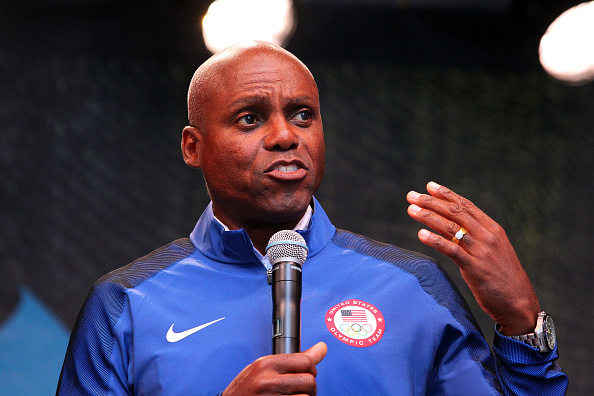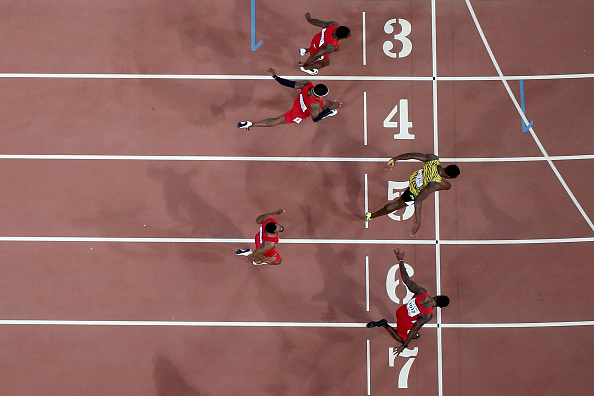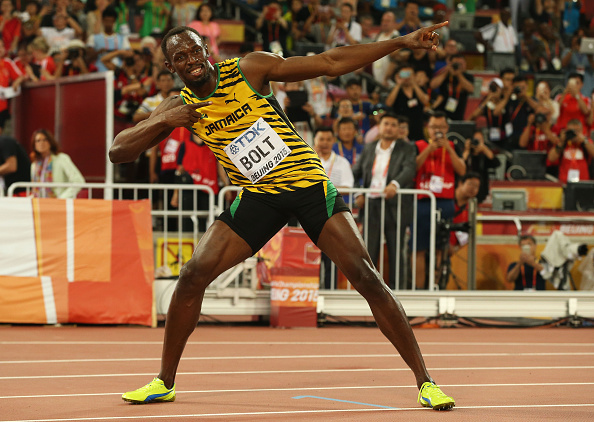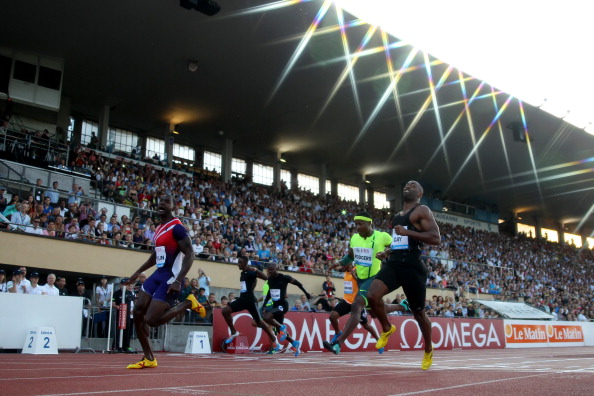BEIJING — Usain Bolt defeated Justin Gatlin in the men’s 200 Thursday night at the 2015 world track and field championships, running the best time in the world this year, 19.55 seconds, to win hands-down.
If the result of this big-time showdown had been the other way around, if Gatlin had won, would earthquakes and tsunamis roil the planet? Would sinkholes swallow up large towns? Meteors flash across the sky?
Of course not.
Gatlin finished in 19.74. Just as he did in the 100 Sunday night, Gatlin lost his form — this time, about six steps from the finish — but managed to keep it together enough for second.

What happened Thursday, same as Sunday, amounted to great sport and, no small thing, great theater. Bolt yet again proved his worth. And Gatlin proved he is a worthy rival.
That’s great for track and field.
Gatlin on Bolt: "I have nothing against Usain. He is a great competitor. A competitor as myself — you know, you look for that. You look to be able to get pushed to your limits, to get pushed to the best times you can run.
"At the end of the day," Gatlin continued, "when you are like 45, 50 years old, and you retire, you want to look back and say, you know what? That guy right there, you helped make history with this guy, helped push him and he pushed you to be a better athlete."
"I have no problem with Justin Gatlin," Bolt said. "He is a competitor."
If Bolt doesn't have a problem with Gatlin, this simple question: why should anyone else?
Bolt also said of Gatlin, "He talks a lot. I have noticed over the years. But that’s just who he is. I’ve noticed that in the lead-up to a championship, he’s going to say a lot of stuff. But after the championships, he confuses you, you feel like he is your best friend."
Track and field too often can find itself in a marginalized niche, a once-every-two- or four-years-thing. The 200, and other events Thursday, offered precisely what the sport needs: big-time stars, and rivalries, and expressed respect.
Allyson Felix, for instance, moving up from the 200 to the 400, exploded from the start in Lane 6 and put on a sprinting clinic to win in 49.26, a 2015 world-best time. Shaunae Miller of the Bahamas took second in 49.67, Shericka Jackson of Jamaica third in 49.99.
The 400 victory made for the ninth world championship gold of Felix’s stellar career. Let the debate begin now in earnest about whether the schedule at next summer's Rio Olympics can be shuffled around so that she can run both the 200 and 400.
In a news conference, Felix was asked the secret not just to her success but her longevity. Simple, she said -- "to be hungry, to be passionate" about sprinting and winning.

In the triple jump, American Christian Taylor, the 2012 Olympic gold medalist, set a new American record, 18.21 meters, or 59 feet, 9 inches, in a competition that -- right before the women's 400 and men's 200 -- seemingly captivated everyone at the Bird’s Nest.
That 18.21 is the second-longest jump in history. Britain’s Jonathan Edwards went 18.29, 60-0 1/4, in 1995. The American record had stood for 19 years: 18.09, 59-4 1/4, Kenny Harrison, to win Olympic gold in Atlanta in 1996.

Second went to Cuba’s Pedro Pichardo, 17.73, 58-2.
"It was a great fight," Taylor said. "I saved it until my last jump."
The 2008 Olympic champ, Portugal’s Nelson Evora, grabbed third on his final jump, a season-best 17.52, or 57-5 3/4. The American Omar Craddock had to settle for fourth, 17.37, 57 feet even.
On Sunday in that 100, Bolt had defeated Gatlin by one-hundredth of a second in a race that far too many billed as a contest between “good” and “evil,” Bolt caricatured as “good” in this made-up morality farce, Gatlin as “evil.”
As things got underway Thursday night, Bolt, announced to a huge roar, kissed the “Jamaica” on his jersey. Gatlin made kissing motions, then “ran” with his hands, also greeted by cheers.
For all the noise about the 100, the 200 has long been Bolt’s preferred race. In Lane 6, he got out of the blocks without incident — he can be a slow starter but not Thursday — and then, coming down the stretch, powered home for the victory, the fifth-fastest 200 ever.
The last time Bolt had run a 200 under 19.6? August 23, 2012.
"The 100 is really for the people, for my coach," Bolt said, "and the 200 is for me."
Earlier this year, Gatlin had run a 19.57. But not this night.
That 19.74, however, is no small thing: it made for the second-fastest non-Bolt time ever at a world championships. The American Walter Dix ran 19.53 at the worlds in Daegu, South Korea, in 2011.
Third place Thursday went to South Africa's Anaso Jobodwana. He ran a national-record 19.87.

To reiterate the obvious:
Bolt runs big on the big stage, and has ever since he burst onto the world scene here at the Bird’s Nest in those Olympics seven long years ago. But for his false start at those 2011 Daegu worlds, he has won virtually everything — 100, 200, 4x100 — at every major meet since, worlds or Olympics. (The U.S. team won the 4x100 at the World Relays this past May, Gatlin running second for the Americans, Bolt anchor for the Jamaicans.)
Bolt is also thoroughly charismatic. He has made “To Di World” a pose recognized the world over.
Bolt got tangled up with a cameraman amid the post-race festivities. No harm, no foul, he said: "I'm fine. It's all fine."

The two-dimensional depiction of Bolt as “good,” it must be emphasized, depends on two things:
One, that he is running clean.
The most, though, that anyone can say about Bolt that he has never tested positive.
That is a long, long way from a guarantee of anything.
To be clear, that's by way of explanation, not accusation; moreover, it must be stressed that nothing has surfaced that would link Bolt to anything undue.
That said, when it comes to the Jamaican track and field landscape, no one, least of all in the media, can be assured of any guarantees; that's too much of an ask given the structural deficiencies that have plagued the Jamaican anti-doping infrastructure, and its woeful lack of testing over the years.
The second point to consider: track and field is not, as some like the chief sports feature writer for the Daily Telegraph, the English newspaper, would have it, a moralistic reflection on athletic piety or purity.
It never has been.
The history of the ancient Olympics in Greece makes that plain.
As David Wallechinsky writes in his authoritative book on the modern Games, "The use of performance-enhancing drugs and concoctions by athletes is nothing new,” noting that the winner of the 1904 Olympic marathon, Thomas Hicks, an English-born brass worker from Cambridge, Massachusetts, “was administered multiple doses of strychnine and brandy during the race.”
Fast forward to Ben Johnson in Seoul, in 1988.
And the BALCO scandal in the United States some 12 years ago.
And allegations now about blood doping in countries around the world.
Track and field, like any enterprise, has its good points — its very, very good points, indeed — and some not so good.
This, then, is what follows logically:
Things in track and field, as in all spheres in life, are not simply susceptible to a reduction of good and bad, black and white, yes or no.
If Bolt can be depicted as a hero — have at it, if you want to.
The same, though, for Gatlin — for years, he has been a study in humility and courage, working his way back from the embarrassment and shame, indeed the mortification, of two doping positives.
Redemption is just as powerful a lesson as anything, and for anyone. Who goes through life without mistakes?
Gatlin’s agent, Renaldo Nehemiah, told the BBC, “He has humbled himself for months and months. It was never widely reported so people don't believe he has made amends or apologized."
Late Thursday, Nehemiah in an interview, said, "Consider the woman who’s afraid the man who’s coming home is going to beat her -- she's reading all this, realizing [Gatlin] is a fighter, he’s standing tall.
"That’s where the lessons can be learned. There are so many people who can look at this and say, wow, this guy has persevered through relentless criticism -- criticism that was heaped on him unfairly."
To carry the inquiry further — if Bolt is the “saviour of the sport,” as the British track and field Athletics Weekly blared in its front-page headline after the 100, what would have been the case had Gatlin prevailed Thursday night? Would Bolt personally be to blame for any and all ills the sport might confront?
Of course not. This is why the entire construct is not just completely absurd and over-the-top ridiculous but entirely unfair — to Bolt, to Gatlin and, moreover, anyone.
Further, what gets lost in the depiction of Bolt as “good” or Gatlin as “evil” is elemental: facts.
And with facts come context.
And nuance.
In the real world, these things matter.
Anyone in the public eye deserve these things, at the very least.
Gatlin’s first positive test came in 2001, when he was 19, for prescription medicine he was taking for attention-deficit disorder.
As for the second, a testosterone pop in 2006, it makes much more sense upon a read of the record — all of which is publicly available in a federal courthouse in Pensacola, Florida — to infer that the positive test may well have resulted from a shot or a pill, administered by assistant coach Randall Evans, the injection witnessed in person by coach Trevor Graham.
Graham is of course one of the central figures in the BALCO case.
There is no support in the record for the assertion that a massage therapist rubbed steroid cream on Gatlin. That theory, according to the documents, came from Graham.
Facts. They really matter, or at least you’d like to think so.
In that same column in the Telegraph, written by the paper’s chief sports feature writer, under a headline that declares Gatlin is a “bothersome impediment to athletics’ rehabilitation in the eyes of a jaded public” — absolutely not one bit of which is supported by any factual assertion — the column declares about Gatlin, “He has not had to reimburse any of the money that he earned during the time when he was found to have doped.”
Nehemiah, Sunday night, under the Bird’s Nest: “He never stole any money. When he got banned, he never ran another race.”
The set-up to that line about Gatlin’s finances, again from the Telegraph column: “What exactly constitutes payback in his case?” Then, after the line about reimbursement: “The damage he has suffered is purely reputational. This, when it comes to administering any kind of potent deterrent to dopers, is not enough.”
In Gatlin’s 2007 hearing stemming from the 2006 test, Nehemiah would testify that the second test cost Gatlin “5, 6 million dollars.” Gatlin, Nehemiah said, had grossed $1.549 million in 2005; projections in 2006 alone, the agent said, were for “anywhere from $2.5 to $3 million.”
As for payback?
Why is any sort of “payback” a thing? Payback does not equal deterrence. That is simply illogical, it being a maxim of legal theory that sanctions exist for four purposes: retribution, incapacitation, deterrence and rehabilitation.
Payback is not making someone a villain because it suits an easy narrative. That’s grossly unfair.
At any rate, you want deterrence?
Five to six million dollars and four years out, humbling yourself by teaching 8-year-olds in and around Atlanta how to run — that’s powerful deterrence.
You know what else is important in reporting about these kinds of things? Consistency.
Another high-profile sprinter who got busted in the BALCO scandal, as all familiar with track and field would know: the British star Dwain Chambers.
After a lot of legal to and fro, Chambers was ultimately cleared again to run.
Earlier this year, the Telegraph included Gatlin on a list of what it called “the most hated sportsmen in the world,” a “sport-by-sport breakdown of the most loathsome individuals.”
Indeed, in the piece published Wednesday: "Any drugs cheats who decide to revive their careers must accept that it is their lot to endure a reception rife with suspicion and innuendo."
Here, just last year, after he won the British 100 meter championship, was this same newspaper, a different reporter at the byline, hero-making on Chambers:
“After the athletics season last year Chambers climbed Mont Blanc in support of the charity Teens Unite and he revealed the experience had given him the mental strength to keeping racing. ‘I’ve climbed many mountains, haven’t I? And fallen down a few,’ he said. ‘But I still keep standing. Climbing that mountain was for a different cause, but it showed me a lot about myself. That was a lot of pressure. I was scared, because any false slip I was a goner. I had to keep my wits about me. But doing that made me believe and understand that I can do anything.
‘I was totally out of my comfort zone, walking 250 [meters] up an hour. It normally takes me about 25 seconds to do that. But it was a real test of character for me and it’s given me the ability to still come out here and compete.’ "
Even more, last August from the European track and field championships in Zurich, here was the writer now designated the chief sports feature writer, after first describing Chambers as “avowedly reformed and ever-complex”:
“Once ostracized, Chambers has been accepted back into the fold due to the apparent sincerity of his contrition.”
Fair is, you know, fair.
Recognizing what he was up against coming into this meet, Gatlin acknowledged late Thursday, "It was never my intent to come to these championships and and try win over any fans or change the view of who I am. My intent was to come here and compete to the best of my abilities. That's what my job is.
"I think the people saw a different view of me: you know, I'm just a competitor, man. I have no ill will toward Usain, no ill will towards anybody. We have all worked very, very hard all season long, just trying to stay away from injury. And just get out there and run 9 seconds, run 19 seconds, and get on that podium. Mission accomplished.
"I came out of here with some hardware," he said. Now it's time "to get ready for the 4x100 and get ready for Rio."
Where Bolt and Gatlin, all things being equal, get to go at each other again. It's all good.

















